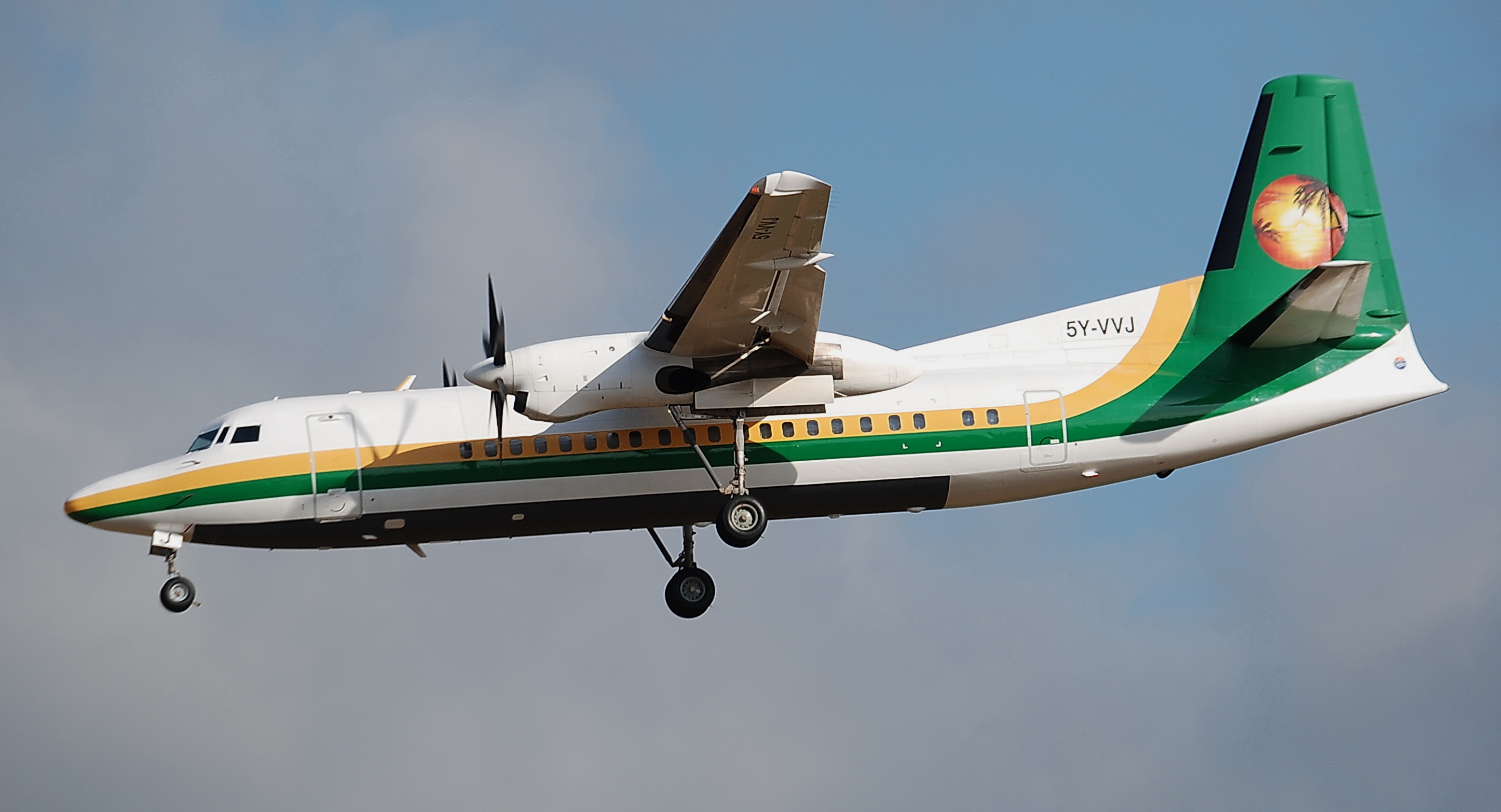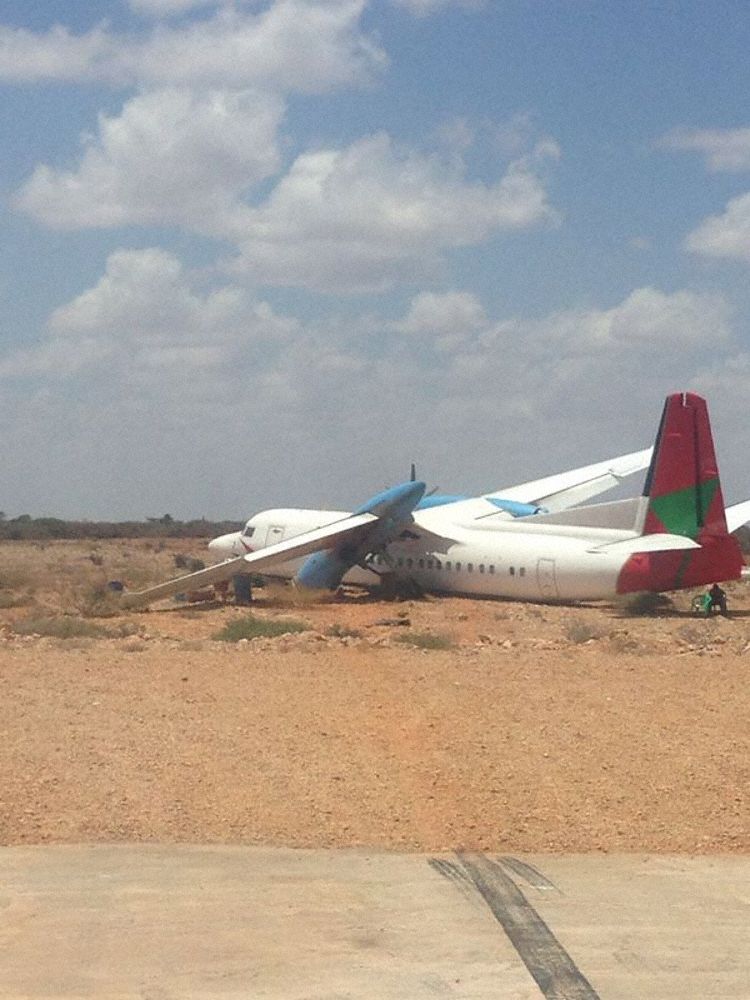Crash of a Britten Norman BN-2A Islander near Chirundu
Date & Time:
Jul 6, 2014 at 1630 LT
Registration:
9Q-CYA
Survivors:
Yes
Schedule:
Lanseria – Lubumbashi
MSN:
617
YOM:
1970
Crew on board:
2
Crew fatalities:
Pax on board:
0
Pax fatalities:
Other fatalities:
Total fatalities:
0
Circumstances:
The crew departed Lanseria on a positioning flight to Lubumbashi where the aircraft was based. En route, the crew encountered engine problems and elected to make an emergency landing on the Lusaka - Chirundu Road. Eventually, the twin engine aircraft crashed in a cliff. Both occupants were injured and the aircraft was destroyed.

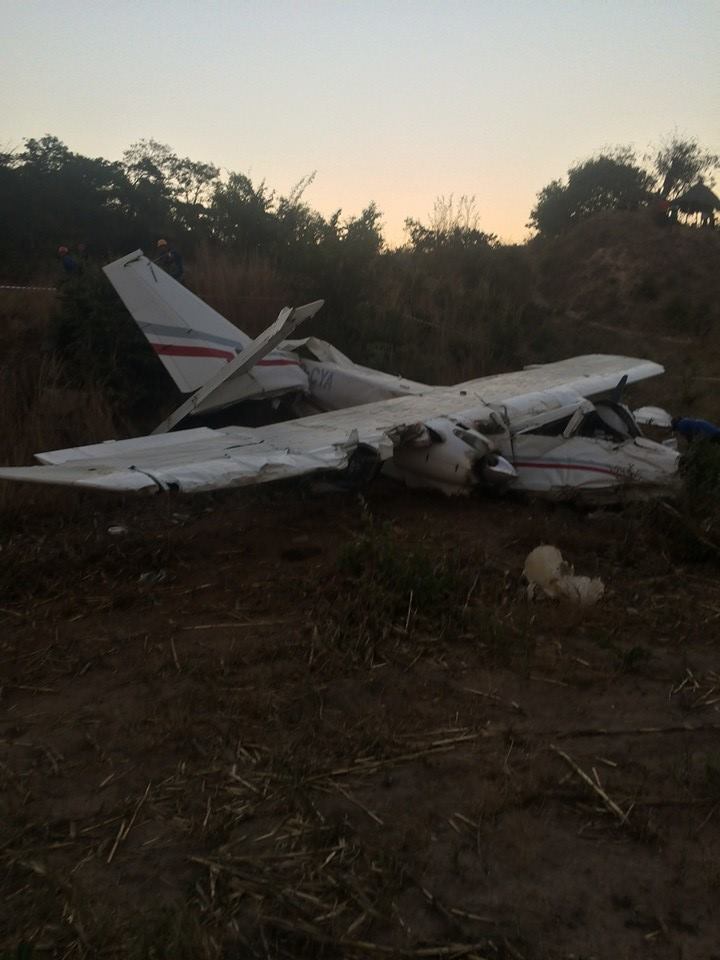


Crash of a Fokker 50 in Nairobi: 4 killed
Date & Time:
Jul 2, 2014 at 0417 LT
Registration:
5Y-CET
Survivors:
No
Schedule:
Nairobi - Mogadishu
MSN:
20262
YOM:
26
Crew on board:
2
Crew fatalities:
Pax on board:
2
Pax fatalities:
Other fatalities:
Total fatalities:
4
Captain / Total hours on type:
6821.00
Copilot / Total hours on type:
513
Aircraft flight hours:
27342
Aircraft flight cycles:
26358
Circumstances:
On 2 July 2014, about 01.14 UTC, 5Y-CET, a Fokker F50, an international cargo flight, operated by Skyward International, crashed shortly after takeoff from Jomo Kenyatta International Airport (JKIA), Nairobi, Kenya (JKIA). Instrument Meteorological Conditions prevailed at the time and the airplane was on an instrument flight plan. The four crewmembers were fatally injured. The airplane was destroyed and consumed by post-crash fire. The destination of the flight was Aden Adee International Airport, Mogadishu, Somalia. The airplane was repositioned from its home base at Wilson Airport in Nairobi, the day before. The accident captain (CAPT) and another first officer conducted the repositioning flight. (see Aircraft Information). At JKIA, the airplane was loaded with cargo in preparation for the accident flight. The accident crew consisted of the Capt and FO in addition to a maintenance engineer and loadmaster. According to air traffic control (ATC), the flight plan was filed for duration of 2.5 hours at an altitude of 19,000 feet along with 5 hours of fuel aboard. Based on flight recorder data, the Capt was the pilot-flying and the FO was the pilot-monitoring. The accident flight was reconstructed using data from air traffic control and flight recorder information. According to FDR data, engine start occurred at at 01.50.20. At about 01.10.59 the flight made initial contact with JKIA air traffic control tower and after routine communication, including the confirmation of the number of person and fuel endurance, the flight was cleared for takeoff at 0112.30. At 01.11.58, both engines accelerated to a high power setting with engine no. 1 stabilizing at 78% torque, 100% propeller speed and engine 2 stabilizing at 80% torque, 99% propeller speed. About six seconds later, the Capt indicates “power is set”. About 2 seconds afterwards the Capt indicated “the auto-feather is off, left” and then 5 seconds later, the FO calls out “seven eighty” (?). About 16 seconds after initial engine acceleration was applied, the first of a series of three chimes audio alerts occurred, and continued at 1 second interval throughout the CVR recording. Immediately after the initial chimes, the Capt said “you see” and “how much is that?”. The FO responded “okay niner”. The Capt then asked “it has gotten to?” The FO replied “thirty four thirty ninety two” and shortly afterward “the left one is thirty”. About 24 seconds after initial engine acceleration, engine 1 torque climbs over a period of 2 seconds to a recorded value of 119.9%, the maximum value the recorder is capable of recording. Simultaneously Engine 1 propeller speed falls from 100% to 57%. Other engine shaft speeds remain at approximately their original high power values. Airspeed at the point this change occurs was less than 30 knots. During this period, the FO called out “one twenty two now [pause] torque”. The Capt responded “it is rising eh? The FO then noted “torque one twenty six now”. About 31 seconds after initial engine acceleration, the FO called out “okay speed alive sixty”. About a second later the Capt asked “do we reduce or”? The FO responded “we can just cut”. The Capt inquired “do we abort or continue?” The FO responded, “okay one one twelve and nine four point three” and then “okay one sixteen [pause] ninety four.” The Capt acknowledged “yeah okay” About 47 seconds after initial engine acceleration, the Capt said twice “did I reduce it?”and the FO responded sequentially “yeah” and “okay”] About 52 seconds after initial engine acceleration, the Capt asked “how is it now?” and the FO replied “yeah one oh two [pause] ninety four”. About 7 seconds later the FO called out “okay, one sixteen ninety four”. About 1 minute after initial engine acceleration, the Capt inquired “Is it really going?” The FO replied “one oh one, ninety five”. The Capt acknowledged and shortly afterward he queried “is it going really, is the aircraft really moving”. The FO responded “okay, one oh one, ninety five”. About 4 seconds later, the Capt indicated “it is not giving power” About 1 minute 9 seconds after the initial engine acceleration the FO called out “okay speed has now reached about hundred”. The Capt responded “oh yeah” and immediately afterward the FO called out “okay one eleven, ninety five”. About 1 minute 18 seconds after the initial engine acceleration, the FO indicated “hundred now”. The Capt acknowledged. About 1 minute 26 seconds after the initial engine acceleration, the FO called out “V one V R rotate” About 1 minute 33 seconds after the initial engine acceleration a transition of the airplane from ground to air mode is recorded and the pressure altitude begins to climb along with the Capt immediately afterward expressing two exclamations. Following the transition to air mode there were 51 seconds of flight recorder data before the recording ended. During this time and over a period of about 3 seconds, the FO calls out “positive rate of climb” and the Capt responded “gear up”. About 3 second later, the Capt expressed “it doesn’t have power [pause] it’s on one side.” About 6 seconds afterward, the FO said “we can also turn back”. About 3 seconds later the first of seven “don’t sink” (GPWS aural warning alerts) begins over a period of 23 seconds. After the second GPWS alert the Capt queried “ok, we’re ok?” After the third GPWS alert, the FO said “we can turn back” and the Capt immediately responded “let’s just go”. The FO replied “okay”. After the fifth GPWS alert, the Capt indicated “and this one is showing one fourteen” and then queried? “we can turn back?”. About 2 seconds later, the FO called out “okay speed is one hundred” and the Capt responded “but this one has nothing” About 1 second later and about the time of the sixth GPW alert, JKIA control tower radioed “five yankee charlie echo tango contact radar one two three decimal three. Good morning.” After the seventh GPWS alert the recording ended about 13 seconds later. During this time, the controller called the aircraft again. The Capt expressed “tell him [pause] tell him we have no power”. The last CVR data indicates the FO radioed, “ah tower charlie echo” and the transmission abruptly ended along with simultaneous sounds of distress. According to FDR data, about 15 seconds after the airplane transitioned from ground to air mode the recorded altitude peaked about 5060 feet and accompanied by a maximum airspeed of 100 knots. Along with a variation of airspeed between 90 knots and 100 knots for the remainder of the recording, during the following 20 seconds the altitude decreased to about 5000 feet and then increased to 5050 feet over the next 10 seconds where it remained until the recording ended at 1.14.27. Witness Accounts (Air Traffic Controller Civilians). The aircraft crashed during the hours of darkness at geographical coordinates of 01° 17’16”S, 36° 57’5”E.
Probable cause:
The probable cause of the accident was the decision by the crew to conduct the flight with a known mechanical problem and their failure to abort or reject the takeoff after receiving twenty seven cautions.
The following findings were identified:
- A three chime alert occurred during the positioning flight from HKNW to HKJK,
- Crew continued with the flight with a known fault,
- No evidence that remedial maintenance action was taken after landing from that flight prior to the event flight,
- No evidence of the anomaly being captured in the aircraft technical log,
- At least one of the occupants during the event flight, possibly the PIC, had been present during the positioning flight and thus was aware of the three chime alert that had occurred then,
- Twenty seven sound of three chime alert event occurred during the take off roll on the accident flight,
- The aforementioned alert occurred well before V1,
- The left engine exhibited high torque values (in excess of 120%) while the left propeller speed was reduced to the range between 45% to 55% rpm for most of the flight,
- Crew continued with take of roll and subsequent rotation despite the twenty seven chime alert,
- When airborne, crew contemplated turning back but eventually elected to continue with the flight,
- Cargo weight exceeded what was indicated in the load sheet 36,
- There was no evidence of any maintenance having been conducted on the aircraft since its Certificate of Airworthiness issue two months previously (9th May 2014).
The following findings were identified:
- A three chime alert occurred during the positioning flight from HKNW to HKJK,
- Crew continued with the flight with a known fault,
- No evidence that remedial maintenance action was taken after landing from that flight prior to the event flight,
- No evidence of the anomaly being captured in the aircraft technical log,
- At least one of the occupants during the event flight, possibly the PIC, had been present during the positioning flight and thus was aware of the three chime alert that had occurred then,
- Twenty seven sound of three chime alert event occurred during the take off roll on the accident flight,
- The aforementioned alert occurred well before V1,
- The left engine exhibited high torque values (in excess of 120%) while the left propeller speed was reduced to the range between 45% to 55% rpm for most of the flight,
- Crew continued with take of roll and subsequent rotation despite the twenty seven chime alert,
- When airborne, crew contemplated turning back but eventually elected to continue with the flight,
- Cargo weight exceeded what was indicated in the load sheet 36,
- There was no evidence of any maintenance having been conducted on the aircraft since its Certificate of Airworthiness issue two months previously (9th May 2014).
Final Report:








Crash of a Cessna 208 Caravan I Near Lydenburg: 3 killed
Date & Time:
Jun 17, 2014 at 1030 LT
Registration:
3006
Survivors:
Yes
Schedule:
Sabi Sabi - Lydenburg
MSN:
208-00136
YOM:
1988
Crew on board:
2
Crew fatalities:
Pax on board:
3
Pax fatalities:
Other fatalities:
Total fatalities:
3
Circumstances:
The single engine aircraft was completing a training flight from Sabi Sabi to Lydenburg on behalf of the 41st Squadron. While descending to Lydenburg, the aircraft crashed in a mountainous area near the Long Tom Pass. Two passengers were seriously injured while three other occupants were killed.

Crash of a Harbin Yunsunji Y-12-II in El Wak: 1 killed
Date & Time:
May 12, 2014
Registration:
KAF124
Survivors:
Yes
Schedule:
Mandera – El Wak – Garissa – Nairobi
MSN:
0095
YOM:
1997
Crew on board:
2
Crew fatalities:
Pax on board:
10
Pax fatalities:
Other fatalities:
Total fatalities:
1
Circumstances:
Shortly after takeoff from El Wak Airfield, bound for Garissa, the twin engine aircraft stalled and crashed. The copilot was killed while 11 other occupants were injured. The aircraft was destroyed.

Crash of a Fokker 100 in Ganla
Date & Time:
May 10, 2014 at 2000 LT
Registration:
5N-SIK
Survivors:
Yes
Schedule:
Bratislava – Ghardaïa – Kano
MSN:
11286
YOM:
1989
Crew on board:
2
Crew fatalities:
Pax on board:
0
Pax fatalities:
Other fatalities:
Total fatalities:
0
Circumstances:
Following a C-Check at Bratislava Airport, the aircraft was returning to its base in Kano, Nigeria, with an intermediate stop in Ghardaïa. While flying over the Niger airspace, the crew was in contact with Niamey ATC when he apparently encountered poor weather conditions (sand storm) and lost all communications. The exact circumstances of the accident are unclear, but it is believed that the crew was forced to attempt an emergency landing due to fuel shortage. The aircraft landed in a desert area located in the region of the Ganla beacon, south of Niger. Upon landing, the aircraft lost its undercarriage and slid for few dozen metres before coming to rest. Both pilots evacuated safely and the aircraft was damaged beyond repair. The wreckage was found about 190 km north of Kano.

Crash of a Piper PA-46-310P Malibu near Niekerkshoop: 2 killed
Date & Time:
Apr 22, 2014 at 1121 LT
Registration:
ZS-LLD
Survivors:
No
Schedule:
Cape Town – Swartwater
MSN:
46-8408063
YOM:
1984
Crew on board:
1
Crew fatalities:
Pax on board:
1
Pax fatalities:
Other fatalities:
Total fatalities:
2
Captain / Total hours on type:
163.00
Aircraft flight hours:
2029
Circumstances:
On 22 April 2014 at approximately 0716Z the Commercial pilot accompanied by a passenger departed Cape Town International Airport (FACT) on an IFR flight to Swartwater in the Limpopo Province. Approximately 16 minutes after take-off with the aircraft climbing through an altitude of 13500 feet to 17000 feet, the Air Traffic Controller advised the pilot that the aircraft’s Mode C transponder started transmitting erroneous altitude data and indicating that the aircraft was descending whereas the pilot thought he was ascending. The pilot notified the ATC that the aircraft was not descending and attempted to rectify the problem by recycling the Mode C transponder that however didn’t resolve the problem. As the transponder information was intermittent during the IFR flight to Swartwater, the ATC requested the pilot to descent to the VFR flight level FL 135. The pilot then requested Area West for approval to ascent to flight level (FL 195) which was approved. It appears that the pilot was unaware that the pitot static tube system that supplies both pitot and static air pressure for the airspeed indicator, altimeter and triple indicator was most probably blocked by dust or sand. The aircraft exceeded the Maximum Structural Air Speed (VNO) of the aircraft and the VNE air speed of 1 hour 44 minutes and 9 minutes respectively. The VNO of 173 airspeed and VNE of 203 airspeed exceedance resulted in the catastrophic inflight breakup of the aircraft. The wreckage was found scattered in a 1.58km path in mountainous terrain. Both occupants on board the aircraft sustained fatal injuries.
Probable cause:
The aircraft exceeded the Maximum Structural Cruising Speed (VNO) and Calibrated Never Exceed Speed VNE airspeed due to the fact that erroneous airspeed and altitude data information indicated on the cockpit instruments as a result of blockage of the pitot tube by dust and sand. The fact that the pilot switched off the transponder was considered as a contributory factor.
Final Report:
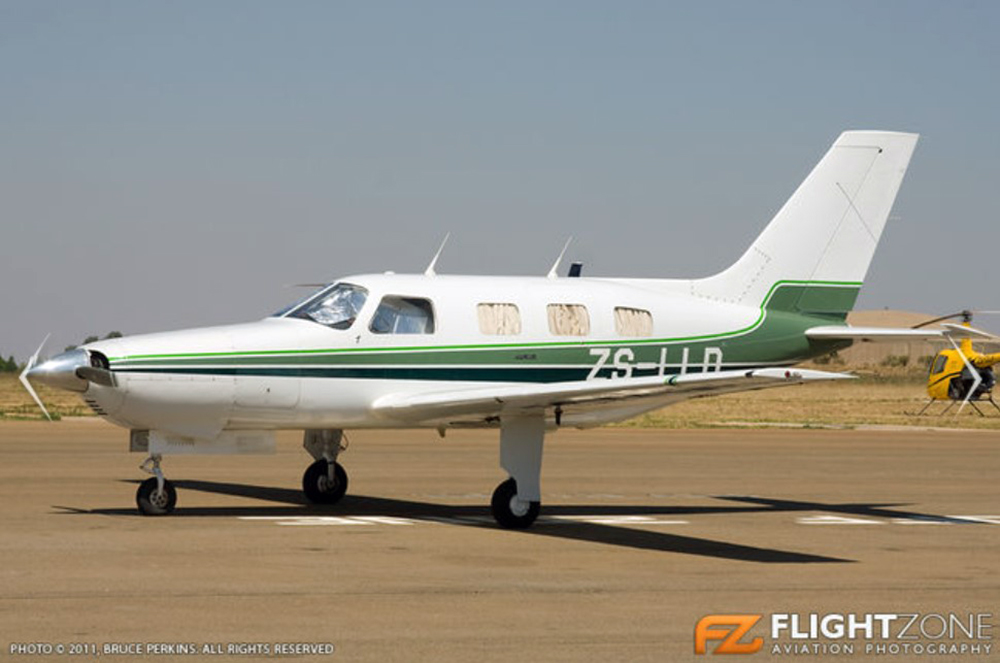

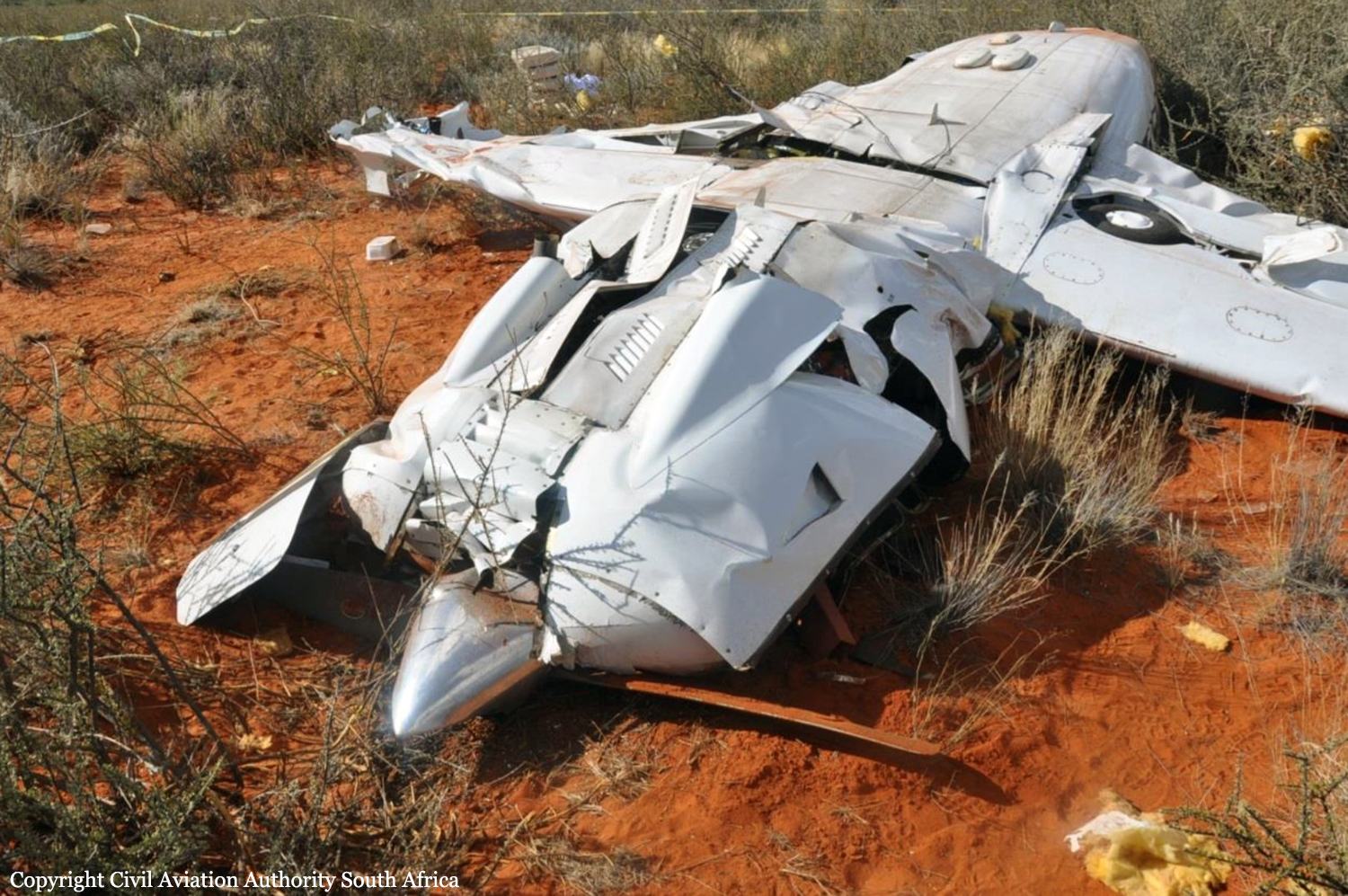
Crash of a Fokker 50 in Guriceel
Date & Time:
Apr 20, 2014
Registration:
5Y-VVJ
Survivors:
Yes
Schedule:
Nairobi – Guriceel
MSN:
20133
YOM:
1988
Crew on board:
2
Crew fatalities:
Pax on board:
0
Pax fatalities:
Other fatalities:
Total fatalities:
0
Circumstances:
The aircraft departed Nairobi-Wilson Airport on a cargo flight to Guriceel, carrying two pilots and a load of six tons of khat. After landing, the crew encountered difficulties to stop the airplane within the remaining distance. The aircraft overran and came to rest with its left wing partially torn off. Both pilots evacuated safely and the aircraft was damaged beyond repair.
